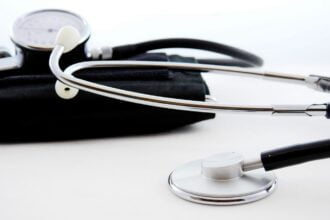When Les Baugh was 17 years old, his step brother bet him five bucks that he could beat him in a footrace. They started off, and Baugh eventually won. As he turned back to look at his brother, he ran straight into a set of power lines. The electricity went right through him and doctors at the hospital thought he was a goner. They said he’d never be able to walk again, that he might not even live to be 21.
When Les Baugh was 17 years old, his step brother bet him five bucks that he could beat him in a footrace. They started off, and Baugh eventually won. As he turned back to look at his brother, he ran straight into a set of power lines. The electricity went right through him and doctors at the hospital thought he was a goner. They said he’d never be able to walk again, that he might not even live to be 21.
Miraculously, Baugh lived. But he lost both his arms after that accident. It took him a long time to get back on his feet, to come to terms with his handicap. But he decided he would learn to live despite his shortcomings and make something of himself. And he did.
A video by The New York Times features 59-year-old Baugh going about his day as a double amputee. On a cold winter’s night, Baugh is seen lifting logs of wood with his foot and tossing them into the fireplace. He strikes a match with his mouth and lights the fire. He is shown getting into his car, using his mouth to pull out a wooden spoon from a cup attached to his car window and turning on the radio. One foot on the gas pedal, the other on a steering mechanism and off he goes.
Over 40 years after that freak accident, Les Baugh made headlines on May 21, 2015 as the world’s first bionic man.
Only Bilateral Shoulder-level Amputee to Wear Two MPLs at the Same Time
Baugh is helping out at the Applied Physics Laboratory at John Hopkins University, testing an advanced robotic prosthetic created by them. The next-generation prosthetic has 26 joints and can be controlled by the human mind, similar to a regular arm.
It would be nice, Baugh says in an interview with The New York Times, “to feel whole again. Not to ask people, ‘hey could you grab this for me, or put this in my cart because I can’t get it off the shelf’.” It would be great, he adds, to have “something else other than my mouth to do that with.”
Baugh recently underwent surgery at Hopkins to remap the remaining nerves from his missing arms, allowing signals from the brain to be sent to the prosthetic. The custom socket strapped onto Baugh can pick up brain signals and control the movement of the arms simply by thinking it. Baugh is the “first bilateral shoulder-level amputee” to wear two MPLs simultaneously.
The arms, called Modular Prosthetic Limbs (MPL) have been tested at the Applied Physics Lab (APL) at Hopkins by patients with varying disabilities.
“A First for Simultaneous Bimanual Control”
This is a breakthrough in the field of neurology and researchers and engineers behind this development believe that it is possible for patients to feel sensation in the prostheses.
Mike McLoughlin, APL’s chief engineer of research and exploratory development, explains in an interview with TODAYonline that each arm has over 100 sensors and as the remapped nerves grow deeper, patients like Baugh who have undergone a procedure called targeted muscle reinnervention will be able to feel sensation and texture through the MPL.
Using the MPL needs training. Courtney Moran, one of the researchers, observed that Baugh was an exceptional test subject. “He was able to learn and control motions in a short period of time and was instrumental in a major milestone with MPL control,” she says in an interview with technology blog Engadget. “Baugh was able to control dual motions across both arms at the same time, which was a first for simultaneous bimanual control.”
The MPL is yet to receive approval from the US FDA and the cost too needs to be brought down to a tenth of its current price (approx. US$500,000 each) so that consumers can actually afford to use them.
The APL’s long-term goal is to find more ways for humans to be able to control dexterous robotic devices without any invasive surgeries or implants.
Neural Implants Hoping to Restore Smooth Movement to the Disabled
Thirty-four-year-old Erik Sorto has been paralyzed for 13 years after he was shot in the back. Paralyzed from the neck down, this father of two recently picked up a bottle of beer and put it to his lips for the first time since the shooting. All thanks to the robotic arm and two silicon chips implanted in his brain.
The experimental neural implant, developed by researchers at the University of Utah, is the latest in a series of prosthetic devices that promise to restore smooth movement to those without limbs, by tapping into brain signals.
The tiny chips were implanted into Sorto’s brain during a five-hour surgery by doctors at the University of Southern California. Beginning with a handshake and graduating to more complex tasks, Sorto has been working with occupational therapists from Rancho Los Amigos National Rehabilitation Center and Caltech scientists to practice and fine-tune his movements.
“Can Move an Ankle I didn’t even have for 11yrs”
On May 20, 2015, David Ingvasson and Gummi Olafsson became the only two amputees in the world to be able to subconsciously control their lower-limb prostheses. Thanks to tiny sensors implanted in the residual muscle tissue of these two amputees, the muscles pick up the brain signals, which move their way into the prosthetics, allowing the prosthetics to react to what the brain wants.
The implanted myoelectric sensors (IMES) are developed by Ossur, an Icelandic orthopedics company and were provided by US-based Alfred Mann Foundation. Ossur unveiled the IMES technology this month and is getting ready for large-scale clinical trials.
Olafsson lived in pain for 28 years before he decided to let doctors amputate his right foot and lower leg after a childhood traffic accident. After an entire decade of being unable to move his ankle, Olafsson at age 48, can finally do that just by thinking about it.
“It has been surreal,” Olafsson told Erik Sofge of Popular Science Magazine. “I haven’t had an ankle in 11 years, and now I can actually move it. To be honest, the first time I did it, I started to cry.”
The new generation of mind-controlled prosthetic technologies comes with its own set of software challenges. The results nonetheless, have been incredible, revolutionizing, and mind-boggling. And this is just the beginning.








